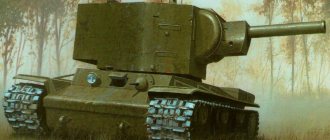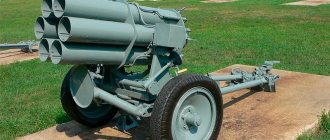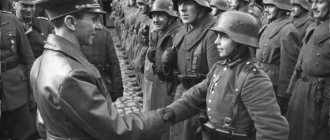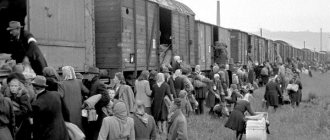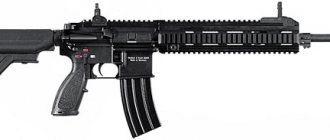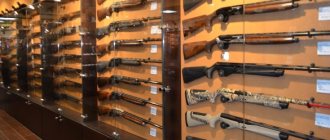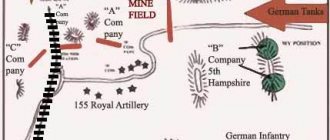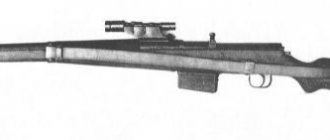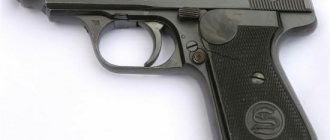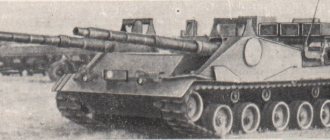In 1941, Germany forms the Fifth Panzer Group.
Home "
boroda 01/02/2011 920
0
in Favoritesin Favoritesfrom Favorites 0
Article from the restored one.
I came across this article on a site very far from alternative history, on the respected tank site Chobitka - https://armor.kiev.ua/Battle/WWII/5tg/. The tattoo was given by a colleague of doktorkurgan.
For the invasion of the Soviet Union, four tank groups were formed: 1st TGr von Kleist, 2nd TGr Guderian, 3rd TGr Hoth, 4th TGr Hepner. The “armored fist of the Wehrmacht” walked through enemy territory, losing people and equipment in fierce battles with the Red Army. Neither the last soldier nor the last tank was enough to strike the Coup de main... In the fall of 1941, tank groups were recognized as “first among equals” and renamed tank armies, which freed them from moral subordination to infantrymen. Von Arnim's 5th Panzer Army was created in Africa, where in May 1943 it capitulated to the Anglo-American allies. That. The Fifth Panzer Group never existed, but to consider the possibility
the formation of the 5th TGr by June 22, 1941 can and should be done, having assessed the volume of captured weapons and special equipment that the Wehrmacht received in Europe.
I propose, as it seems to me, just a hurricane alternative - Germany still forms the fifth tank group and uses it.
Now, my colleagues, I propose to play for the Germans and propose a scenario that would give them the opportunity to win the war.
The main question immediately becomes - in which place on the Eastern Front it is best to use it. Maybe in the direction of the main strike. And it will help the Germans begin the battle for Moscow at the end of August - beginning of September. Maybe in the northern part, and thanks to it, Leningrad will be taken. Maybe in the south, and with its help, break through to Stalingrad by the end of summer and cut off oil supplies to the USSR in 1941. Or maybe the craziest option is to use it in Africa in 1941, and with its help Germany will solve all its problems with fuel for the entire long war, capturing Iraq, or even Iran and Baku (here you can actually kill two birds with one stone, and provide themselves with oil and deprive the USSR of it).
Well, further information about the composition of the Fifth Tank Group of the Wehrmacht.
Formation
Based on the average number of 4 existing TGr, the hypothetical 5th TGr could have the following composition:
1. Headquarters 2. 3 motorized corps of 5 tank and 3 motorized divisions; 3. Division of the RGK self-propelled tank destroyers; 4. Division of the RGK flamethrower tanks; 5. 6 engineer (pionier) battalions; 6. Command (headquarters) of engineer battalions; 7. 3rd motorized cannon division of the RGK; 8. 2nd motorized howitzer division of the RGK; 9. 7 mixed divisions of anti-aircraft guns of the RGK (Wehrmacht); 10. 3rd division of heavy anti-aircraft guns (Luftwaffe); 11. Command (headquarters) of anti-aircraft artillery (Luftwaffe). 12. Logistics services
In total, the 5th TGr was supposed to include:
- about 130,000 personnel;
- 875 linear tanks (175 in a tank division), of which 100 are “heavy” T-4 types;
- 33 flamethrower tanks;
- 31 self-propelled tank destroyers;
- 673 armored vehicles, of which 500 are infantry armored personnel carriers;
- 564 mortars
- 1,704 guns, of which: 465 anti-tank;
- 160 light and 38 heavy infantry guns (small direct infantry support howitzer gun, 75-150 mm);
- 228 divisional howitzers (from 105 mm);
- 96 heavy divisional howitzers (from 150 mm);
- 27 RGK guns (from 100 mm);
- 18 RGK howitzers (from 200 mm);
- 568 light anti-aircraft guns (from 20 mm);
- 104 heavy anti-aircraft guns (from 75 mm);
- 10,345 motorcycles;
From captured European equipment, you should choose analogues that are equal in combat qualities to German models or even superior (such as the Lorrein 37L tracked tractor) to them.
Tanks
Each tank division included 20 heavy (according to the German classification) T-4 with a short-barreled 75-mm gun, designed to support infantry. A replacement could be the Char B-1bis. With anti-ballistic armor, armed with 47-mm (anti-tank) and 75-mm (anti-personnel) guns, the tank did not reach a speed higher than 25 km/h, but, as V. Chobitok pointed out, the marching speed of a tank division was determined not by the maximum speed of the tanks, but by the speed artillery carts and did not exceed 15-20 km/h. The tank corresponding to the average T-3 was the Somua S-35. Anti-ballistic armor, 47 mm gun, maximum speed 35 km/h. The Germans got 400 tanks of this type, therefore, 70 Somuas can be assigned to each of the 5 etc. Hotchkiss H-39 or Renault R-35 could be used as light tanks. According to the French classification, the Hotchkiss was a cavalry tank with a speed of up to 40 km/h, and the Renault was a low-speed infantry escort tank. Von Manstein's 56th Motorized Corps, which took the fastest pace from the border, was accompanied by a 47-mm self-propelled gun based on the R-35 and, apparently, did not lag behind. To equip 5 tank divisions, 425 light tanks were required, 85 per division (with the captured number of 843 R-35 and 600 N-39). By 1940, 25% of French light tanks (about 350 units) were equipped with a long-barreled 37-mm SA38 L\33 gun. A certain amount of SA38 lay in warehouses, the factories were not destroyed (Hotchkiss and Saumur resumed work in August 1940), therefore the Germans could rearm most of the light Hotchkiss and Renault with them. That. per tank division there were 20 Char B-1bis, 70 Somua S-35 and 85 Renault R-35(39) or Hotchkiss H-35(39). I will also note that the tank crew was increased by one more person - the loader. The division of crew functions, if not at the level of T-3 and T-4, was approximately equivalent to Russian tanks. Tanks were required to be equipped with radio stations.
tank B1. France" src="https://alternathistory.com/files/120310_5TGr_02.jpg" />
Flamethrower tanks
When choosing equipment for a flamethrower division, you don’t even need to delve into alternative history. The 102nd flamethrower battalion, equipped with linear and flamethrower B-1bis tanks, became part of the 4th Army Corps of the 17th PA GA South, operating in the summer of 1941 during breakthroughs of fortified defenses. A division (abteilung - battalion or division?) could consist of 2 companies of Char B-1bis (16 vehicles per company + commander’s linear vehicle), for a total of 24 flamethrowers and 9 linear vehicles.
Self-propelled tank destroyers
The situation is similar with the tank destroyer. By June 22, 1941, the Alkett company had produced 126 4.7cm PaK(t) auf Pz.Kpfw 35R(f). Of these, 33 self-propelled guns remained in reserve on the territory of the Reich and could be included in the division - 27 linear and 4 command vehicles.
Armored vehicles and armored personnel carriers
In tank and motorized divisions, armored vehicles were used for reconnaissance purposes, armed with a machine gun or 20 mm gun and protected by bulletproof armor. Captured wheeled BM Panhard 178 were already distributed among divisions, so you should pay attention to the AMR 33\35, which were considered reconnaissance armored vehicles, but were fast (up to 60 km/h) tracked wedges with bulletproof armor, armed with light (AMR 33) or heavy ( AMR 35) with a machine gun. Most of the AMR was radio-enabled. The Germans captured about 200 armored vehicles, therefore they could equip the reconnaissance battalions of the 5th TGr with them. When choosing armored personnel carriers similar to the famous German Hanomags, a very wide panorama of captured equipment opens up. First of all, the eye falls on the armored tracked tractor and transporter Lorraine 37L\38L. I think it would not be a great exaggeration to call this vehicle the best infantry armored personnel carrier created in the pre-war and war years. Not inferior to the half-track Ganomags and the American M3 in terms of armor (bulletproof), Lorraine surpassed them in cross-country ability due to its tracked propulsion. A fairly high specific power (13 hp per ton of weight) made it possible to later turn the armored personnel carrier into a carrier of a variety of weapons, up to a heavy 150-mm howitzer. Lorraine could carry: 37L - 6 people or 500 kg, 38L - 6 people or 1000 kg of cargo. 4 people or another half ton of cargo could be transported in a special tracked trailer. The total production of armored personnel carriers before the surrender was 508 units. The usually declared figure of 300 captured Lorrains indicates, according to German documents, their number in 1942. Thus. at least 300 Lorraine armored personnel carriers could transport motorized infantry in the 5th TGr. In principle, this could be limited, because There were not enough Ganomagi and usually only one battalion moved in armored personnel carriers, while the rest moved in trucks. However, the Unic P.107 and Somua MCG half-track tractors were quite suitable for the role of infantry armored personnel carriers after installing an armored hull. This was demonstrated by the Germans in 43-44, when, frankly speaking, it was already too late. I will also note that P.107 and MCG looked like twin brothers; MCG was slightly larger than P.107 in size. It is difficult to distinguish them in photographs. Characteristic differences: 1. R.107 had 6 studs on the front wheels, MCG - 8; 2. The drive wheel and idler R.107 are spoked, and the MCG is disc. Until the surrender of France, 3,276 Unic P.107s and 2,543 Somua MCGs were produced. About 4,500 serviceable half-tracks fell into the hands of the Germans; this number made it possible to equip another 200 armored personnel carriers on their basis. Please pay attention to the last photo. An armored personnel carrier based on the French Laffly 15T tractor. The middle bridge is hidden by a bulwark, the outline of the wheel is visible in the background. The image of the Krauts driving around in Soviet three-axle armored personnel carriers in films apparently has a basis in reality.
Personal weapon
On June 25, 1940, the French army laid down its arms. A huge amount of small arms, grenades, anti-personnel and anti-tank mines passed into the hands of the winners. Below is a list of samples most suitable for equipping the 5th TGr.
In addition to these samples, the Germans captured a total of about 3 million more small arms, including Gewehr 241, 301, 302, 304(f) rifles, Karabiner.553(f) carbines, Selbstlade-Gewehr.310(f) automatic rifles and Gewehr.303(f) sniper rifles, rifle grenade launchers, heavy anti-aircraft machine guns sMG 256, 257(f). Beginning in 1942, captured weapons were supplied to stationary divisions of the Atlantic Wall and partly to divisions undergoing reorganization in Europe.
Mortars
The main mortars of the French army were 60 mm and 81 mm. In total, 6,000 60 mm mortars and 8,000 81 mm were captured in France. This was more than enough to staff the 5th TGr. A. Shirokorad notes that the ballistics (in other words, range and accuracy) of the 81-mm 8cm s.Gr.W.278(f) were higher than those of the German counterpart.
Anti-tank guns
In France, a large number (several hundred) of 25-mm model were captured. 34 and 37 and 47-mm anti-tank gun arr. 1937. If the 25-mm gun corresponded to the 37-mm Pak-35/36 anti-tank gun, then the 47-mm was only slightly inferior in armor-piercing power to the 50-mm Pak-38 anti-tank gun (40 mm and 60 mm at 400 m, respectively) and could be used against all Soviet tanks. The Germans captured 823 47-mm anti-tank guns. The gun carriage was sprung, the speed of the cart reached 40 km/h.
Infantry guns
The German 75 mm le.IG18 and 150 mm sIG33 direct infantry support can be called unique in their class. Both guns combined the properties of a cannon (ground fire), a howitzer (mounted fire) and a mortar (mounted fire with an over-caliber mine). They were equipped with a wide range of projectiles (high-explosive, armor-piercing, cumulative, over-caliber mine) and variable charges. However, you can find analogues for them - the English 94-mm Vickers mountain howitzer and the Dutch 120-mm Bofors howitzer. The first was a light gun-howitzer mod. 1918, standard equipment of English infantry regiments. To move through difficult terrain - mountains, jungles - it could be disassembled into several parts and transported in packs on horses or mules. The expeditionary force deployed about 200 94-mm howitzers on the continent. The second, the 120-mm Bofors, weighed slightly less than the 150-mm German infantry gun and had a lighter high-explosive projectile (17 kg versus 38). But even a 105-mm divisional howitzer shell (14 kg) turned bunkers inside out, therefore Bofors could be used to support infantry units with some success. In Holland, 40 howitzers were captured.
Divisional howitzers
French 105 mm howitzer mod. 1935 (Canon de 105 court Mle 1935 B) in its characteristics was a worthy opponent to the German light howitzer. The only significant differences were the wooden wheels and unsprung ride. Since the Canon de 105 weighed 200 kg less than its German counterpart, I think the introduction of suspension for 228 (out of hundreds of captured) howitzers into the carriage was not an insoluble problem.
Heavy divisional howitzers
Schneider's 155-mm howitzer fought in the First World War (Canon de 155 long Mle 1917), and was modernized in 1930 - mounted on metal wheels with cast rubber tires, the carriage was sprung. Compared to the German 150-mm sFH18, the Schneider howitzer had the same projectile weight and a maximum range only 2 km shorter. A significant drawback was the single-beam carriage, as a result of which the horizontal aiming angle was 6 degrees. unlike the German howitzer (56 gr). The Germans got about 2,000 Mle 1917, and they found wide use in 43-44. on the Eastern and Western fronts. Ammunition for them was produced by French and German factories throughout the war. To equip the 5th TGr, only 96 155-mm Schneider howitzers were required.
Howitzers RGK
Heavy RGK howitzers had a shorter range than cannons, but due to their larger caliber and hinged trajectory they could reliably hit targets hidden behind terrain, such as headquarters, concrete fortifications, bridges, and enemy batteries. A tank group was usually assigned one or two divisions of 210 mm Mrs.18. The howitzer was carried disassembled (a carriage with a limber and a barrel cart), and for short distances - assembled at a reduced speed. The transfer to the combat position took about half an hour - the front end was unhooked, the barrel was pulled onto the carriage, the frame was lowered to the ground, and the wheels were hung out. Mrs.18 was a mobile and powerful weapon; European howitzers of this class were either inferior in range or required digging a pit to install the carriage base. The most suitable replacements for Mrs.18 were the 203 mm (8 inch) Vickers Mk6 howitzer and the 220 mm Schneider TRL howitzer. Although I personally like the Vickers howitzer (the Mk6 modification had a range of about 12 km, a sprung carriage and, which is generally unique for European heavy artillery, spoked wheels with inflatable tires), fairness requires choosing the French 22-cm Mrs.531(f) TRL . Actually, in the second half of the war, most of these howitzers were on the Eastern Front. Like the German howitzer, the 220 mm TRL was transported on two wagons and fired from the base or from the wheels. Due to a significantly shorter barrel and smaller charge, Mrs.18 was inferior in range (12 km versus 16), but was lighter, had a sprung carriage and a projectile of the same mass (about 100 kg).
Light anti-aircraft guns
By June 1940, the French army was armed with a varied fleet of 20-40 mm anti-aircraft artillery (Hotchkiss, Schneider, Oerlikon, Bofors), about 1,900 pieces in total. These were mainly modern (developed in the late 30s) mobile guns with sprung carriages that allowed mechanical traction. The most common MZO was the 25-mm Hotchkiss mod. 1938 - 748 pcs. The anti-aircraft gun was a rapid-firing machine gun on a single-axle carriage. To put it into combat position, three frames with jacks at the ends were lowered onto the ground, and the wheels were removed. In addition to air targets, the anti-aircraft gun could also hit ground targets. The Hotchkiss shell was the same as the 25 mm anti-tank missile.
Heavy anti-aircraft guns
Unlike the Wehrmacht, where mobile 8-8s were attached to mobile formations and could accompany them with fire, the French army did not have heavy anti-aircraft guns. All anti-aircraft artillery with a caliber of 75 mm and above was concentrated around large cities and airfields. However, I do not insist on this thesis, because There is almost no information, apparently it can only be found in special publications. I got the impression that if the small ZA was shooting at the enemy with sin, then the heavy one seemed to exist in another dimension. In general, in terms of the number of barrels (2,500 pieces of 88 and 105 mm), the Wehrmacht was slightly superior to the enemy (1,890 pieces in France alone, excluding the heavy anti-aircraft artillery of the English Expeditionary Force). But the outdated (not only in the use of tanks, but also aviation) military doctrine backfired on the Europeans: divisions with only 6 (infantry) and 40 (motorized) MZOs were mercilessly bombed from the air. Of the 2,000 aircraft lost by the Germans, only about 50 were shot down by anti-aircraft artillery. A large number of heavy anti-aircraft guns were captured by the Germans intact, including 94-mm English ones (QF 4.5-in Mk II). The French ones, modernized in the mid-30s and intended for mobile operations, were mounted on interesting carriages - single-axle with 4 beds. When moving to the transport position, two frames were raised, and two were coupled together and attached to the hook of the towing vehicle. About 160 Canon CA 75mm Mle 1933 from Schneider alone were captured.
Vehicles
After the victory of 1940, the Reich had all the resources of the conquered countries at its disposal, incl. and automotive. The total transport fleet of France (including civilian vehicles) in 1940 was 2.3 million vehicles. Around Dunkirk alone, 130,000 roadworthy vehicles were identified and accounted for. Until 1943, 2 million vehicles were requisitioned from France for the needs of the Reich and Wehrmacht, and 350 thousand were exported from Belgium during the same period. Some of the captured vehicles included army trucks and off-road artillery tractors. Although the exact number of trophies in the ranks of the Wehrmacht, if not a sealed secret, then a mystery shrouded in darkness, some figures are known and are presented below in the form of a table.
Until June 22, 1941, the rear services of 88 infantry, 3 motorized and one tank divisions were equipped with captured European vehicles. In numbers, this is not very much - 3,561 passenger cars, 54,912 trucks and 704 tractors. Complaints about the “particularly low” cross-country ability of French trucks are little understood. The lion's share of the vehicle fleet of both the Red Army, the Wehrmacht, and the European armies were cargo vehicles with one driven rear axle, capable of moving along Russian off-road roads mainly according to the “one, two, take” principle. The German tank corps and tank group did not burden themselves with rear structures other than divisional ones. Other transport was under the control of the OKH quartermaster, to whom Army Group headquarters forwarded supply requirements. The following table shows the distribution of tractors in the 5th TGr based on the staffing strength of the rear units of the divisions, individual engineer battalions, artillery RGK and anti-aircraft battalions.
Means of communication
Continuous and precise control was an important component of the successful actions of the Tank Group - a conglomerate of mobile forces. In conditions of maneuvering operations, the communication system relied on radio stations. They, from company to corps, had to be portable or mounted on a chassis. Of course, the Wehrmacht's radio communications were perfect and developed for its time, but one should not imagine it as exceptional. Thus, in France, a significant range of army radio stations was mass-produced, presented in the table below. All French tanks had space for a radio station, and on the Somua S-35 and Char B-1bis there was also a niche for an additional commander's station. Heavy divisional and hull r/s were installed on vehicles, all-terrain chassis or BA. Thus, the 5th TGr could be equipped with French r\s. The Germans got not only trophies, as such, but also factories, work teams, production models and experimental developments.
italics
— location of the radio station “+” sign — additional radio stations for command tanks ER — transceiver R — receiver
Personnel
On June 22, 17 tank and 14 motorized divisions of the Wehrmacht crossed the Soviet border. Of these, 8 TD and 7 MD were formed in October 1940 by transforming 2 motorized and 13 infantry divisions. From the issuance of the order for retraining and formation to the entry into battle, 9 months passed (of which about 3-4 were spent putting together divisions). Two TDs (2nd and 5th, two-regiment composition), having handed over their military equipment, were in Germany, in the OKH reserve.
To staff the 5th TGr, personnel were required for 5 tank and 3 motorized divisions, as well as other reinforcement and support units. The main question was about the training of tank crews, because tractors and armored personnel carriers were not combat vehicles, but served to quickly deliver artillery and infantry to the battlefield.
In the West, the 44th Infantry Divisions were left as occupation troops. That. the artillerymen and infantrymen had plenty and had already smelled gunpowder in the European campaign. The OKH reserve in the fall of 1940 was about 300,000 reservists who had completed a 3-month training course. They could be used to train drivers or withdraw them from the rear structures of several infantry divisions.
In August 1940, the personnel of the 2nd and 5th tank divisions, as well as the formed 201st tank regiment, received captured materiel for training. The French served as instructors. In general, the accounting of trophies was completed in September and the 201st tank battalion was followed by the 100th, 202nd, 203rd, 204th and 10 separate tank battalions. Their preparation was completed by March 1941. There were 3 months left to organize trained tank crews, experienced artillerymen and united infantry into combat-ready mobile divisions...
Commanders[ | ]
- Colonel General E. Hoepner (February 15, 1941 - January 7, 1942)
- Colonel General R. Ruoff (January 8, 1942 - May 31, 1942)
- Colonel General G. Goth (May 31, 1942 - November 10, 1943)
- Colonel General E. Rous (November 10, 1943 - April 21, 1944)[3]
- Colonel General J. Harpe (May 18, 1944 - June 28, 1944)
- General of Tank Forces V. Nering (June 28, 1944 - August 5, 1944)
- General of Tank Forces H. Balck (August 5, 1944 - September 21, 1944)
- General of Tank Forces F.-G. Gräser (September 21, 1944 – May 8, 1945)
